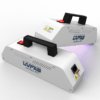Ultraviolet (UV) radiation is a broad-spectrum antimicrobial agent that has been applied successfully in a wide range of disinfection applications. UV radiation in the wavelength range 200-320nm, sometimes referred to as “germicidal” or “microbicidal” UV radiation, is known to cause damage to DNA and RNA that results in the inactivation of microorganisms and viruses. For radiation with wavelengths less than about 240 nm, damage to proteins can also contribute to inactivation. Given that all viruses contain a nucleic acid molecule, either DNA or RNA, and a protein coat (called a capsid) that surrounds the nucleic acid, all viruses are susceptible to inactivation by exposure to UV. However, viral sensitivity to UV is quite variable, though the development of a comprehensive understanding of the causative factors is still an active area of research.
SARS-CoV-2 (aka the novel coronavirus) is the virus that causes Coronavirus Disease 2019 (COVID-19). Transmission of COVID-19 appears to be largely associated with airborne particles that may be released by symptomatic or asymptomatic individuals who have been infected by SARS-CoV-2,1 although it is also known that the virus can remain infective on surfaces for as much as 24-72 hours, depending on the material it is contact with,2 so contact with surfaces represents another possible mechanism of disease transfer.


 UVFAB Systems, Inc.
UVFAB Systems, Inc. UVFAB Systems
UVFAB Systems